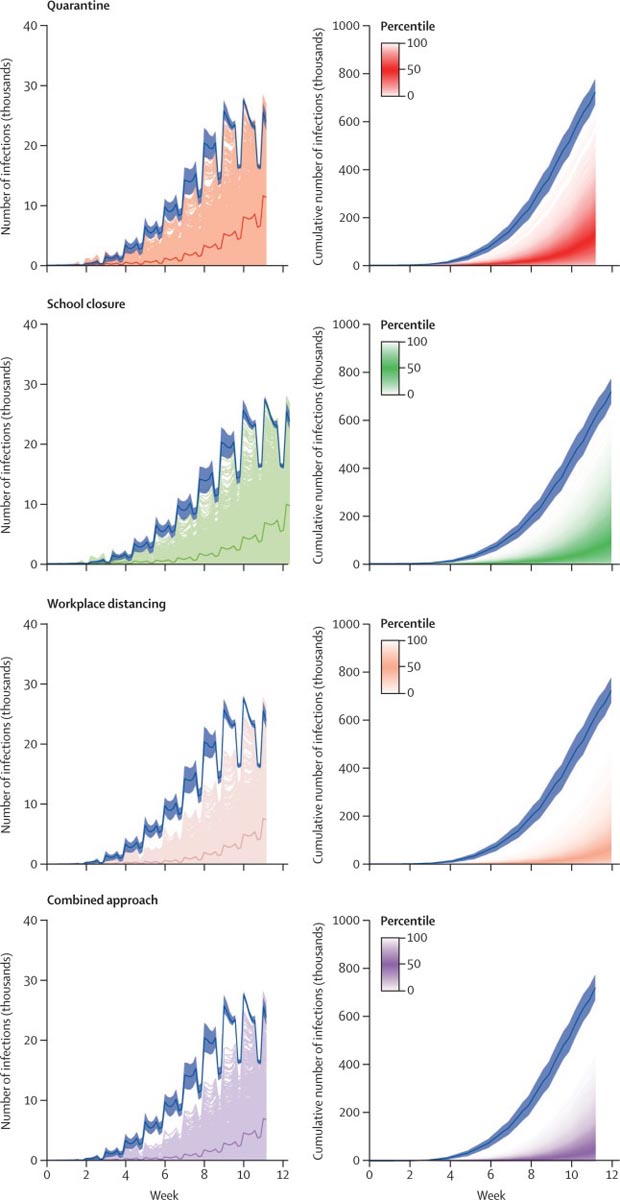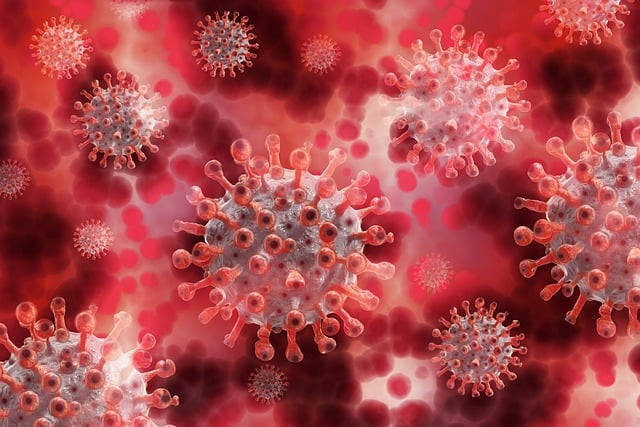Background
Since the coronavirus disease 2019 outbreak began in the Chinese city of Wuhan on December 31, 2019, 68 imported cases and 175 locally acquired infections have been reported in Singapore.
Our objective was to investigate early intervention options in Singapore in the event that local containment (e.g., preventing the spread of the disease through contact tracing efforts) was unsuccessful.
Methods
We adapted an influenza epidemic simulation model to estimate the probability of human-to-human transmission of severe acute respiratory syndrome coronavirus 2 (SARS-CoV-2) in a simulated Singapore population.
Using this model, we estimate the cumulative number of SARS-CoV-2 infections at 80 days, after the detection of 100 cases of community transmission, under three infectivity scenarios (basic reproduction number [R0] of 1 5, 2 · 0, or 2 · 5) and assuming that 7 · 5% of infections are asymptomatic.
We first ran the model assuming there was no established intervention (reference scenario), and then evaluated the effect of four intervention scenarios compared to one reference scenario on outbreak size and progression for each R0 value.
These scenarios included measures of:
- Isolation for infected individuals and quarantine of family members (hereinafter, quarantine).
- Quarantine plus school closure.
- Quarantine plus distancing from the workplace.
- Quarantine, school closure and workplace distancing (hereinafter, the combined intervention).
We also did sensitivity analyzes by altering the asymptomatic fraction of infections (22.7%, 30.0%, 40.0%, and 50.0%) to compare outbreak sizes under the same control measures.
recommendations
For the reference scenario, when R0 was 1·5, the median cumulative number of infections on day 80 was 279,000 (IQR 245,000–320,000), corresponding to 7·4% (IQR 6·5–8· 5) The resident population of Singapore.
The median number of infections increased with increasing infectivity: 727,000 cases (670,000–776,000) when R0 was 2·0, corresponding to 19·3% (17·8–20·6) of the Singapore population, and 1,207,000 cases (1,164,000–1,249,000) when R0 was 2·5, corresponding to 32% (30·9–33·1) of the Singapore population.
Compared to the reference scenario, the combined intervention was the most effective , reducing the estimated mean number of infections by 99·3% (IQR 92·6–99·9) when R0 was 1·5, by 93·0%. (81 5–99 7) when R0 was 2 0, and in 78 2% (59 0 −94 4) when R0 was 2 5.
Assuming increasing asymptomatic fractions to 50·0%, up to 277,000 infections were estimated to have occurred at day 80 with the combined intervention relative to 1800 for baseline at R0 of 1·5.
Interpretation Implementing the combined intervention of quarantining infected individuals and their family members, workplace distancing, and school closure once community transmission has been detected could substantially reduce the number of SARS-CoV infections. -2.
However, distance to quarantine and the workplace should be prioritized over school closure because at this early stage, symptomatic children have higher school dropout rates than symptomatic adults from work. At higher asymptomatic proportions, the effectiveness of the intervention could be substantially reduced, necessitating the need for effective case management and treatment, and preventative measures such as vaccines. |

Total daily number and cumulative number of SARS-CoV-2 infections up to 80 days in different intervention scenarios when R0 is 2·0
Research in context Currently, in Wuhan, the capital of Hubei Province in China, an outbreak of coronavirus disease 2019 (COVID-19), caused by the 2019 novel coronavirus, severe acute respiratory syndrome coronavirus 2 ( SARS-CoV-2; previously called 2019-nCoV). Evidence to date has suggested rapid spread of the virus: at the time of writing, imported cases have been reported in 143 countries and territories, including Singapore. 243 confirmed cases have been reported in Singapore; however, this number is expected to increase substantially in the coming weeks. In 2003, SARS-CoV, which also originated in mainland China, established itself locally and caused 33 deaths after 238 cases were confirmed. There is therefore considerable concern as 3,204 deaths and 81,048 cases of COVID-19 have already been confirmed in mainland China, exceeding the numbers seen in the SARS-CoV outbreak. The 2020 Lunar New Year celebrations have now ended, marking a period of extensive travel between China and Singapore, and a corresponding high risk for case importation. Despite increased surveillance and isolation of people suspected of having COVID-19 and confirmed cases, the risk remains, and the number of cases continues to rise in Singapore. Immediate deployment of interventions to contain the outbreak will be required if significant secondary local transmission is observed within the community. PubMed was searched from database inception to February 26, 2020, for articles using the search terms “Wuhan coronavirus,” “COVID-19,” “SARS-CoV-2,” “ 2019-nCoV" and "coronavirus interventions". Our search returned three relevant articles. Two articles investigated the effects of travel restrictions in Wuhan during the early stages of the outbreak; one of the articles additionally investigated the effects of quarantine in China, and the other article estimated the effectiveness of airport screening in detecting infected travelers. We found no articles evaluating the effectiveness of immediate national control measures outside China. Added value of this study This study is the first to investigate the use of isolation for people with COVID-19 and quarantine of family members, school closures and workplace distancing as interventions for the immediate control of COVID-19 in case of local transmission secondary school using a simulation model. We found that a combined approach (including quarantine, school closures, and workplace distancing) could prevent a national outbreak at low levels of infectivity and reduce the number of total infections considerably at higher levels of infectivity.
Implications of all available evidence The results of this study provide evidence to policymakers in Singapore and other countries to begin the implementation of relatively standard outbreak control measures that could mitigate or reduce local transmission rates if implemented effectively and in a timely manner. . |
















